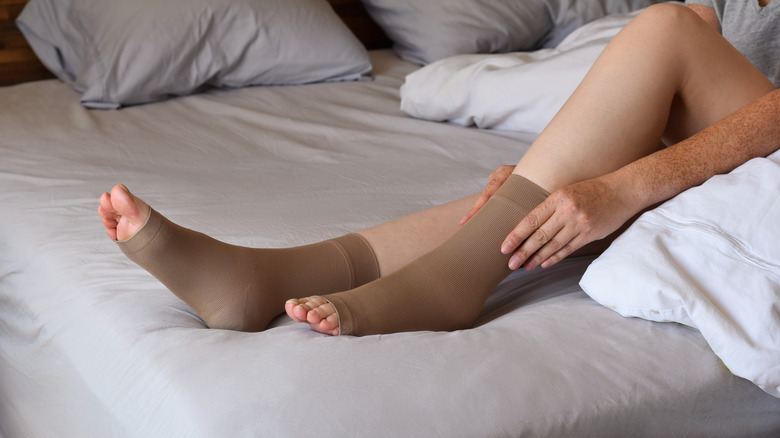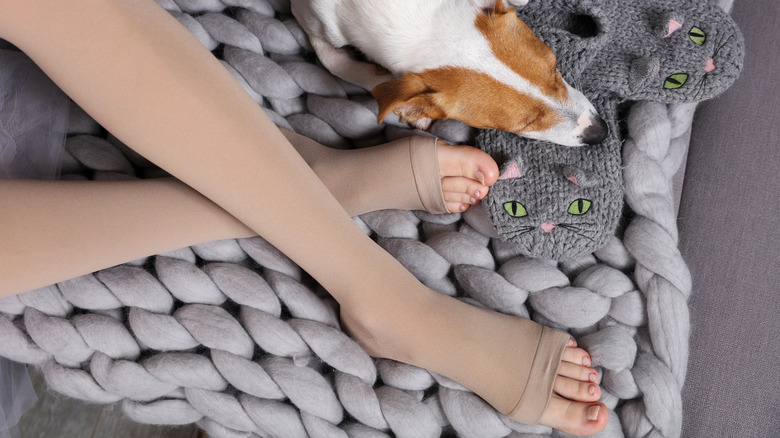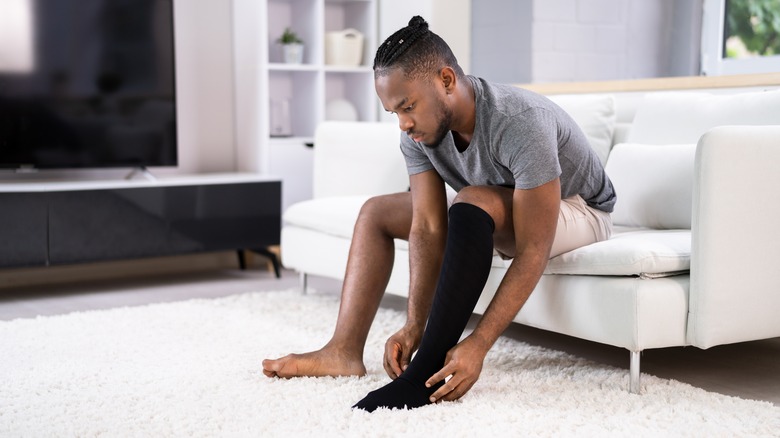Is It Safe To Sleep In Compression Socks? Here's What We Know
Compression socks apply pressure to the legs, ankles, and feet. By doing so, they help improve blood flow and prevent the pooling of blood in the veins, which can be highly beneficial for people who suffer from circulation issues or who are at risk for blood clots. In addition, compression socks can also be useful for athletes, reducing muscle soreness and potentially speeding up recovery by increasing blood flow. A 2015 study published in The Journal of Strength and Conditioning Research showed significantly faster recovery in runners who wore compression socks for 48 hours following a marathon, even while they slept.
However, it's important to note that wearing compression socks while sleeping can cause discomfort and may not be right for everyone. The benefits and safety of wearing these socks at night depend on several factors, including the individual's medical condition, the type of socks used, and how well they fit.
Benefits of sleeping with compression socks
Wearing compression socks while reclining in bed may not be necessary because the horizontal position removes the influence of gravity and the pressure of one's body weight on the legs. In this relaxed posture, blood circulation tends to improve naturally, diminishing the need for external compression. However, individual circumstances and medical conditions should be considered when deciding whether to wear compression socks during sleep.
One of the primary benefits of wearing compression socks while sleeping is the potential improvement in circulation. Maintaining consistent blood flow throughout the night can be beneficial for people with conditions like venous insufficiency (per Heart of Dixie Vein and Vascular Center). Compression socks can help prevent blood from pooling in the lower limbs, reducing the risk of complications like deep vein thrombosis (DVT) (per American Family Physician). Those who experience leg discomfort at night or have restless leg syndrome might find relief by wearing compression socks (per Healthline). Their gentle pressure can alleviate symptoms and promote a more restful sleep. They can also help open leg wounds heal (per Cleveland Clinic).
Risks of sleeping with compression socks
One of the main concerns, however, is ensuring the right fit and size of compression socks. If they are too tight or ill-fitting, they can lead to discomfort, skin irritation, or even restricted blood flow. Some people may find it uncomfortable to wear compression socks while sleeping, mainly if they are not used to them. Discomfort can disrupt sleep and negate potential benefits.
To avoid discomfort, put on each sock carefully. Roll it down to the heel, insert your foot, and gradually roll the stocking up your leg. Avoid bunching or folding, which can create pressure points. Make sure the sock sits smoothly on your leg without wrinkles or creases that cause discomfort and affect the effectiveness of compression. Finally, check your legs regularly for any signs of skin irritation, redness, or numbness. If you notice any issues, remove the stockings immediately and consult a healthcare professional.
In rare cases, wearing compression socks during sleep might pose a risk of complications, especially if an individual has certain underlying medical conditions or poor circulation.
"If you have peripheral vascular disease affecting your lower extremities, you should not wear compression socks," vein specialist Eugene Ichinose, M.D., told the Oklahoma Heart Institute. "The pressure provided by compression socks may make ischemic disease worse. Diabetic patients can be at increased risk of complications since neuropathy prevents them from feeling the changes in their feet."
Finding a comfortable fit for compression socks
Consult your healthcare provider before purchasing compression socks to determine whether they are right for you. If so, ask what is the appropriate type. Compression socks come in various styles, including knee-high, thigh-high, and full-length stockings. Graduated compression socks are tighter at the ankle and gradually loosen as they move up the leg, promoting blood flow without exerting excessive pressure at any point.
To get the most out of your compression socks while avoiding discomfort or complications, it's also crucial to find the right fit. Take the time to get accurate measurements of your ankle and calf circumference and the length from your heel to just below your knee. Use these measurements as a guide when choosing compression socks. Pay attention to the manufacturer's sizing chart and recommendations. Different brands may have variations in sizing, so always refer to the specific guidelines provided with the product.




